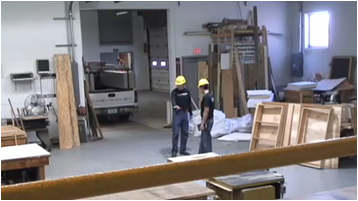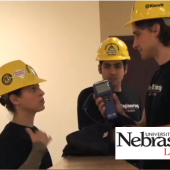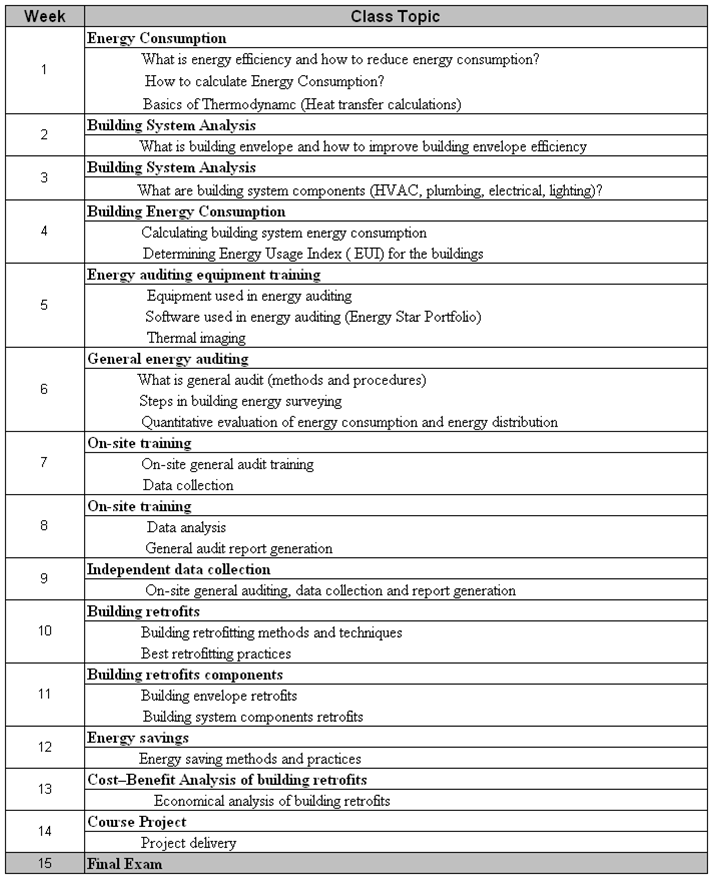Enhancement of the Construction Engineering and Management Curriculum through Physical Energy Assessment of City Facilities
CASE STUDY
As we continue into the future, if we hope to move in the direction of sustainability, the question of energy efficiency in buildings old and new becomes increasingly relevant and key to success. Read this article by Dr. Terri Norton and Matija Ratovic to learn about efforts I the Midwest to prepare university students to take on this task.
INTRODUCTION
In the last couple of years, the United States of America’s (U.S.) drain on energy has become a prominent issue. The rate that energy is consumed in U.S. has overcome rate of which it is produced. It is projected that by the year 2030 the U.S. will annually produce90.3 quadrillion BTUs of energy, while simultaneously consuming 110.9 quadrillion BTUs (U.S. Energy Information Agency Report 2011). The difference, approximately 20.6 quadrillion BTUs (or 22.8 %), will need to be compensated for with imports or energy saving techniques. Additionally, by the year 2016, the average cost of production of one MW of electricity will be $150.9 (Energy Information Administration 2010). The Energy Information Administration 2007 report states that commercial energy use per capita is projected to be about 25 percent higher in 2030 than it is today. As the demand for electricity continues to increase, utility companies will experience great challenges as they try to meet the increasing demand. In addition, the supply capacity is very limited. Building a new fossil fuel power plant is a long process that is heavily opposed by environmental groups. Building a hydro power plant is also a challenge due to plant’s high negative environmental impact. Relying on clean energy sources (solar, wind or geothermal) would not completely solve the energy problem. Clean energy will make up only 3 percent of the total demand by 2030. If utility companies are not able to increase energy production, it may be time to look at the other side of the equation and try to trim energy consumption.
Currently in the U.S., there are 4.8 million commercial and 350,000 industrial facilities (Energy Information Administration 2006). Combined annual energy cost for these buildings is over $200 billion (Energy Information Administration 2006). According to the report from the U.S. Environmental Protection Agency (EPA), staggering 30 percent of the energy used in operating commercial and industrial facilities is used inefficiently or unnecessarily (U.S. Environmental Protection Agency 2007). Over $20 billion can be saved annually if energy conservation measures are employed on commercial buildings and industrial facilities.
According to the U.S. Department of Energy report, it is estimated that up to 50 percent of the energy in buildings is lost due to inadequate insulation (U.S. Department of Energy 2010). If all insulation products are properly installed in buildings it will save consumers about 12 quadrillion BTUs annually or “about 42% of the energy that would have been consumed with no insulation in place” (Green and Competitive Report: Energy Conservation Management 1996). The amount that would be saved by properly insulating commercial buildings is more than 50 percent of the expected U.S. energy deficit at 2030. Since commercial buildings are the biggest consumers of energy, utility companies have reason to initiate (subsidize) conservation efforts. On the other hand, commercial buildings could also benefit from energy conservation by cutting operational costs.
It seems that energy conservation and energy savings are the best alternatives to meet expanding energy demands. In order to conserve energy, we have to determine where and how the energy is consumed in our system. The most efficient way to do this is to audit a building’s energy consumption. Energy audit is a set of rules that breaks down the energy consumption in an existing building into components. When we know how and where energy is used, we are able to determine a proper energy saving method for a particular building. Energy saving methods and processes are known as building retrofits.
According to the EPA BASE study (1994-1998), an overwhelming 96 percent of all buildings in the U.S. were built prior to 1991. Only 35 percent of these buildings are under 35 years old. Knowing that energy saving practice did not exist in near past in the construction industry, it is safe to assume that almost 65 percent of U.S. buildings need energy auditing or building retrofits.
As previously mentioned, there are over 5 million commercial buildings in the U.S., 44 percent are privately owned, 44 percent are government owned (city, state and federal) and 15 percent are classified as academics, such as schools, universities, and institutes (U.S. Environmental Protection Agency, 1998). Knowing that all federal buildings have to achieve a 30 percent reduction in total energy use by 2015 relative to 2005 levels (Energy Independence and Security Act of 2007), the potential market for energy auditing and retrofitting is enormous. Additionally, the same act, Energy Independence and Security Act of 2007, mandates a 55 percent reduction in a building’s fossil fuel use by 2010 from 2003 levels, with complete elimination by 2030. Furthermore, the American Recovery and Reinvestment Act mandates significant funding be appropriated for renovations to federal buildings. It is approximated that the $400 billion will be spent on major green renovations in the commercial building sector. Additionally, it is forecasted that efficiency retrofits will more than triple in annual revenue to $6.6 billion by 2013.
In order to address the problem of energy conservation, International Energy Agency (IEA) developed Energy Conservation in Buildings and Community Systems (ECBCS) program. This program describes energy auditing methodology and lays down a set of rules for energy auditing. According to Annex 11 of ECBCS, there are several steps that the energy auditing process should follow (IEA-ECBCS 1987). In theory, energy assessments are required to identify the most efficient and cost-effective energy conservation methods.
The practice of retrofitting buildings with simple, environmentally friendly technology—better wall insulation, more-efficient boilers, and low emission windows—has been around for years, but there is little research on how much energy these changes actually can save. The problem of implementing retrofitting technologies on existing buildings is associated with high professional labor cost and limited data on savings that building retrofits brings. Recently, engineering programs across U.S. started offering “green” building constructions classes (LEED classes, environmental engineering classes, “green” building management classes and etc). They correctly recognized the need for method that will improve energy conservation at new buildings. However, engineering programs across the country are lagging in developing and offering courses that will address the need for building retrofitting. There are currently 26 ABET accredited construction engineering programs in the U.S. After surveying their course offering for the academic year 2010-2011, we did not find a program that offers an integrated class in energy auditing and building retrofitting.
Currently, there is a need for skilled laborers who are capable of understanding and managing the complete energy assessment process. The objective of this paper is to propose a curriculum for an integrated course in an energy auditing process that would include both academic and practical training.
METHODOLOGY
The best way to enhance student learning is to get students involved in a learning environment where they can learn the theoretical basics of energy auditing and practical applications of a building’s retrofits. In order to achieve this goal, universities must team up with professional employers to provide off-campus learning opportunities. The biggest advantage of this approach is that students will have the opportunity to test their theoretical knowledge gained in the classroom, as well as in the real working environment. It is well known that practical experience enhances the understanding of academic concepts.
A. Tentative Course Plan
The proposed course is aligned with the Sustainable Construction curriculum at the University of Nebraska-Lincoln, Durham School of Architectural Engineering and Construction. This course provides an opportunity for students to gain knowledge on key topics related to the energy assessment of buildings. The topics covered include: energy consumption, building system analysis, grade auditing, thermal assessment, data collection, and building retrofit benefit-cost analysis. The course will also cover design of energy efficient and “healthy buildings”. Design of buildings for low energy use and optimal indoor air quality. Three lecture hours a week for one semester. Course projects will be incorporated to demonstrate practical application of course knowledge. Table 1. provides a tentative course plan.
The course plan follows the procedure for energy assessment developed by American Society of Heating Refrigerating and Air-Conditioning Engineers (ASHRAE).
According to ASHRAE energy auditing process can be divided into four steps: benchmarking, walkthrough, general audit and grade audit (ASHRAE 1997).
During benchmarking, building’s utility bills are analyzed compared with the similar buildings. The walkthrough audit is based on visual verifications and notifications of the building’s installed equipment and operating data. The general audit or real audit is more detailed analysis of the building energy needs and consumption. In this step detailed energy distribution is determined—amount of electricity used for lighting systems, for heating and cooling, and for running various electrical equipment. In this step, quantitative evaluation of energy consumption and energy distribution is determined. A general audit involves detailed surveying of all energy consumers in the building, on-site measurements, and implementation of computer-based models.
The final step in this process is a grade audit. A grade audit involves planning and construction of improvements that fall within the framework of retrofitting a building. During this step, a cost–benefit analysis is conducted in order to determine the best engineering practice for a given project. Detailed technical and business plans are developed to justify the cost of retrofitting.
Table 1. Tentative Course Plan for Integrated Class in Building Energy Auditing and Building Energy Savings Retrofits
In order to conduct and understand the complete energy auditing procedure, students must receive training and education in interdisciplinary knowledge in thermodynamics, building system operation, construction engineering, and cost analysis. The proposed class outline will allow students to gain multidisciplinary knowledge needed to efficiently conduct energy auditing and retrofitting process.
B. City Assessment- Case Study
The University of Nebraska-Lincoln, Durham School of Architectural Engineering and Construction, does not have a class that covers energy auditing and building retrofitting. However, faculty recognize the need for this deficient profile and have taken action toward this end. In 2010, the City of Omaha received a multimillion-dollar grant from the Department of Energy for energy efficiency improvements on the city buildings. An objective of the project was to establish baseline energy consumption for city buildings and to study the long-term efficiency of the energy retrofits. The City of Omaha collaborated with University of Nebraska-Lincoln (UNL), College of Engineering and Kiewit Building Group, in order to complete the project. The UNL College of Engineering was included into the project to engage and train UNL engineering students in the process of energy auditing. It was an excellent opportunity for students to learn about energy auditing and for faculty to pilot proposed class curriculum.
Kiewit Building Group served as the project consultant, providing overall project management and energy auditing training for the students. The subject of energy auditing was not part of the curriculum. Over the course of the project, the City of Omaha decided to make small retrofitting projects on each building and to track how retrofitting changes effected the energy consumption for each. These changes included modifications in electricity and gas and water consumption before and after the completion of the retrofitting process. Data obtained would allow the City of Omaha to determine the best energy saving techniques for future improvements.
C. Energy Auditing Training

Figure 1. Site specific energy auditing training for students was held at City of Omaha Main Maintenance facility
Students were trained in energy auditing and training. Training included theoretical basis of energy auditing (4 weeks), practical on-site visits and data collections (2 weeks), operating energy auditing tools (1 week), and operating energy auditing software Energy Star Portfolio Manager (1 week). The theoretical basis of energy auditing was covered with four 2-hour seminar sessions provided by Kiewit Building Group. Information covered in seminar sessions included the HVAC system in the residential and commercial buildings and fundamentals of energy auditing, thermodynamics and building assessment. The University of Nebraska College of Engineering provided an additional one-hour seminar for training students on the subject of residential energy auditing. Site-specific theoretical basis of energy auditing and building inspections was covered with four 1-hour sessions provided by the commissioning architectural engineer from Kiewit Building Group. During the theoretical basis of the training, students were introduced to project plans and schedules. After covering theoretical basis of the energy auditing process, two weeks of practical on-site visits were conducted in order to strengthen knowledge of energy auditing process. The total of four on-site visits were made to actual city facilities—the Main Administrative Office Building, Waste Processing Plant, Library, and Fire Station.
Each facility visited required unique energy auditing procedures. Students were advised that the auditing process was to begin by interviewing building manager for each facility. Students were given a list of 50 interview questions to assess the energy use of each building. Additionally, the interview questions covered the maintenance history and any past or present issues for each facility. Students were given the opportunity to practice with mock interviews with real building managers. After these mock interviews, the students received immediate feedback. Students received recommendations for formulating questions in an appropriate order. They were also informed that the use of improper interviewing techniques could hinder the success of an audit.
D. Data Collection
After the practical on-site training period, students were sent to collect building survey data for each of the City of Omaha’s ninety-seven facilities. This step required walkthrough energy audit for each building. The City of Omaha’s facilities were divided respectively to six primary types of building spaces—administrative offices, community centers, fire and police stations, libraries, pavilions and caretaker residences, and maintenance and service facilities.

Figure 2. Practical part of the energy auditing training - site visit and data collection at Omaha Waste Treatment Plant
Surveying data that were to be collected were divided up into eight main categories: site, envelope, interior, mechanical, electrical, plumbing, specialty, and programs. In most cases, the assessments took two visits to document and averaging 4 to 6-hours total.
Additionally, general audit was conducted on three city buildings (library, fire station and public recreation facility). Each building represented the most common type of 97 city facilities. General audit of these buildings were to be used as template for remaining 94 facilities. General audit was very time consuming and labor intensive. It took four students and commissioning architectural engineer about 4 hours to collect data on one facility.
Students created Energy Star Portfolio for every City facility. The Energy Star Portfolio is an online software that allows you to track and assess energy and water consumption across a number of buildings. It is a very useful energy management tool that compares your building’s energy consumption against theoretical model buildings, which is statistically derived from a national survey conducted by the Energy Information Administration. Students were supplied with gas, electricity, and water consumption data for all of the City of Omaha’s 97 buildings for up to 15 years. Data from the Energy Star Portfolio was used to generate energy usage index (EUI) for each building. The building’s EUI represents energy consumption normalization factors that allow us to compare energy consumption across the buildings.
DISCUSSION/CONCLUSION
In the move toward sustainability, the need for more energy efficient buildings is an increasingly important topic in the building industry. As that need continues to grow, so does the need for a skilled workforce that can assess, improve, and maintain energy efficient structures. The Durham School of Architectural Engineering and Construction at the University of Nebraska-Lincoln hopes to meet that demand through the courses offered to their students. Through a benchmark study, the EECBG Project with the City of Omaha, the authors were able to explore the possibility of incorporating industry practice into the collegiate learning environment. Although this case study was not in a classroom setting, we were able to achieve a proof of concept. In addition, the students gained a wealth of knowledge from the energy professionals involved in the study. Moreover, the project provided a vehicle for implementing energy efficiency into the college curriculum. The knowledge gained from the case study serves as a foundation for the proposed course presented in this article. The course will include classroom training and on-site training and physical assessment. A pilot for this course will be implemented into the Fall 2011 schedule of classes, as a special topics course.
REFERENCES
Hay, J. C., Sud, I. s. 1997. 4061 (RP-669) -Evaluation of Proposed ASHRAE Energy Audit Form and Procedures. American Society of Heating, Refrigerating and Air-Conditioning Engineers.
Energy Information Administration. 2006. 2003 CBECS Detailed Tables. Building Characteristics Tables for All Buildings (Including Malls), table A1. Energy Information Administration.
Energy Information Administration. 2010. Annual Energy Outlook 2010. Energy Information Administration.
Energy Information Administration. 2006. Expenditures for Sum of Major Fuels for All Buildings 2003. CBECS Detailed Tables. Table C4A. Energy Information Administration.
Energy Conservation Management, Inc. ,Alliance to Save Energy , Barakat & Chamberlin, Inc. 1996. Green and Competitive – The Energy, Environmental, and Economic Benefits of Fiber Glass and Mineral Wool Insulation Products . North American Insulation Manufactured Association .
U.S. Department of Energy. 2010. Radiant Barrier Attic Fact Sheet. U.S. Department of Energy.
IEA-ECBCS . 1987. Annex 11. IEA Energy Conservation in Buildings & Community Systems
U.S. Environmental Protection Agency. 1998. Building Assessment Survey and Evaluation (BASE) study, 1994-1998. U.S. Environmental Protection Agency.
U.S. Environmental Protection Agency, 2007. Energy Star Program. “Useful Facts and Figures.” U.S. Environmental Protection Agency
U.S. Environmental Protection Agency, 2007. Energy Star Program. “The ENERGY STAR Challenge: Build a Better World 10% At a Time.” U.S. Environmental Protection Agency.












 Dr. Terri Norton is an Assistant Professor at the University of Nebraska-Lincoln, in the Durham School of Architectural Engineering and Construction. She has six years of experience in engineering practice, education, and outreach. She has expertise in the areas of hazard vulnerability assessment and energy efficiency. Dr. Norton is the PI for a DOE Energy Efficiency and Conservation Block Grant (EECBG) with the City of Omaha Public Works Facility Management Office and the Kiewit Building Group, which involves training graduate students to perform energy efficiency assessments of city buildings.
Dr. Terri Norton is an Assistant Professor at the University of Nebraska-Lincoln, in the Durham School of Architectural Engineering and Construction. She has six years of experience in engineering practice, education, and outreach. She has expertise in the areas of hazard vulnerability assessment and energy efficiency. Dr. Norton is the PI for a DOE Energy Efficiency and Conservation Block Grant (EECBG) with the City of Omaha Public Works Facility Management Office and the Kiewit Building Group, which involves training graduate students to perform energy efficiency assessments of city buildings. 
